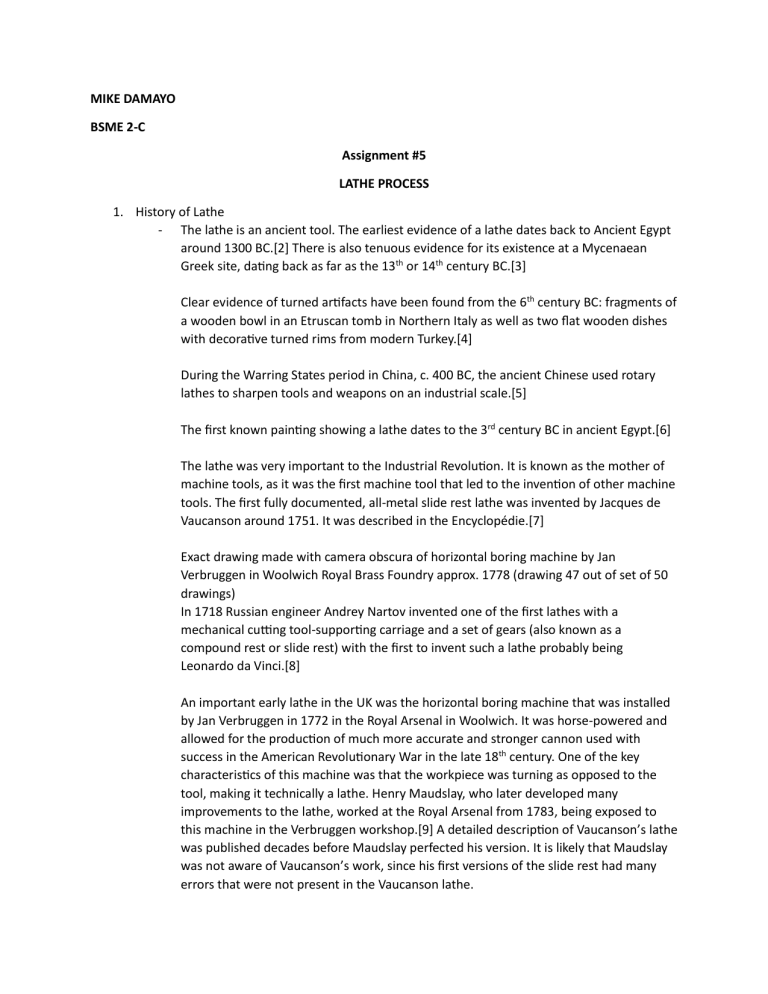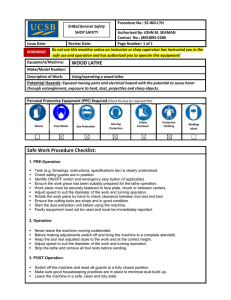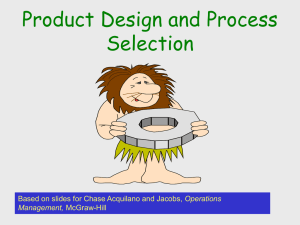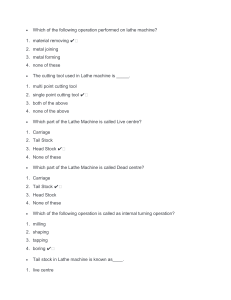
MIKE DAMAYO BSME 2-C Assignment #5 LATHE PROCESS 1. History of Lathe - The lathe is an ancient tool. The earliest evidence of a lathe dates back to Ancient Egypt around 1300 BC.[2] There is also tenuous evidence for its existence at a Mycenaean Greek site, dating back as far as the 13th or 14th century BC.[3] Clear evidence of turned artifacts have been found from the 6th century BC: fragments of a wooden bowl in an Etruscan tomb in Northern Italy as well as two flat wooden dishes with decorative turned rims from modern Turkey.[4] During the Warring States period in China, c. 400 BC, the ancient Chinese used rotary lathes to sharpen tools and weapons on an industrial scale.[5] The first known painting showing a lathe dates to the 3rd century BC in ancient Egypt.[6] The lathe was very important to the Industrial Revolution. It is known as the mother of machine tools, as it was the first machine tool that led to the invention of other machine tools. The first fully documented, all-metal slide rest lathe was invented by Jacques de Vaucanson around 1751. It was described in the Encyclopédie.[7] Exact drawing made with camera obscura of horizontal boring machine by Jan Verbruggen in Woolwich Royal Brass Foundry approx. 1778 (drawing 47 out of set of 50 drawings) In 1718 Russian engineer Andrey Nartov invented one of the first lathes with a mechanical cutting tool-supporting carriage and a set of gears (also known as a compound rest or slide rest) with the first to invent such a lathe probably being Leonardo da Vinci.[8] An important early lathe in the UK was the horizontal boring machine that was installed by Jan Verbruggen in 1772 in the Royal Arsenal in Woolwich. It was horse-powered and allowed for the production of much more accurate and stronger cannon used with success in the American Revolutionary War in the late 18th century. One of the key characteristics of this machine was that the workpiece was turning as opposed to the tool, making it technically a lathe. Henry Maudslay, who later developed many improvements to the lathe, worked at the Royal Arsenal from 1783, being exposed to this machine in the Verbruggen workshop.[9] A detailed description of Vaucanson’s lathe was published decades before Maudslay perfected his version. It is likely that Maudslay was not aware of Vaucanson’s work, since his first versions of the slide rest had many errors that were not present in the Vaucanson lathe. During the Industrial Revolution, mechanized power generated by water wheels or steam engines was transmitted to the lathe via line shafting, allowing faster and easier work. Metalworking lathes evolved into heavier machines with thicker, more rigid parts. Between the late 19th and mid-20th centuries, individual electric motors at each lathe replaced line shafting as the power source. Beginning in the 1950s, servomechanisms were applied to the control of lathes and other machine tools via numerical control, which often was coupled with computers to yield computerized numerical control (CNC). Today manually controlled and CNC lathes coexist in the manufacturing industries. 2. Types of Engine Lathe Speed Lathe Machine - A Speed Lathe Machine is a high-speed, hand-operated lathe machine, mainly used by woodworkers. It can provide a spindle speed from 1200 to 3600rpm. The machine comes with a very simple design, it contains headstock, bed, tailstock, and tool post. Due to their high-speed spindle, speed lathe machines are used for woodturning, furniture making, metal polishing, spinning, and centering. Center Lathe or Engine Lathe Machine- Engine lathe machine is the most popular type of lathe machine. You can find it inside any manufacturing workshop. Nowadays the machine is driven by an electric motor but back in the 19th-century people used steam engines to drive the machine. That’s why it is called an engine lathe machine even it does contain an engine nowadays. It is also called center lathe machine, because back then almost all machine tools were driven by either separate engines or central engines. This type of lathe machine is used for woodworking and metalworking. You can perform various machining operations on this lathe machine… such as turning, facing, grooving, knurling, threading, drilling, boring, reaming, and many more. And lastly, the machine is capable of handling workpieces up to 1 meter in diameter, and up to 4 meters in length. Ingrret Lathe Machine. Toolroom Lathe Machine - This is a special breed of lathe machine mostly used to make precision parts and tools such as die, gauges, jigs, and fixtures. It looks similar to an engine lathe machine. But it is made from more accurate and precise parts than an engine lathe machine. Thus, the price of a toolroom machine is higher than an engine lathe machine. Bench Lathe Machine - A bench lathe machine is a small-size, hand-operated power lathe, mainly used for small precision work. It looks very similar to speed lathe machines. If you have a light job that requires lathe machine operations such as turning, facing, grooving, parting, threading, drilling, boring, knurling, and tapping, this machine is for you. But in general, jewelers and watchmakers use this machine a lot for their machining needs. Automatic Lathe Machine – An automatic Lathe machine comes with a group of mechanisms that makes it capable of changing and feeding cutting tools automatically. When you have a job that is complicated precision operations, requires skills, and you have to produce it in mass quantity… this machine is suitable. Thiis machine is heavyduty, production-friendly, and expensive. Special Purpose Lathe Machine – You can guess by the name, special purpose lathe machines are custom-tailored lathe machines to suit particular needs. They are mostly used for heavy-duty jobs, where regular lathes can’t be used, or using regular lathes can be costlier or time-consuming. CNC Lathe Machine – CNC Lathe Machines are the most up-to-date lathe machines in terms of technology. They come with a modern computer numeric control system (CNC). You can use this control system to add a CAD/CAM program and after that, whenever you command the machine, it will start and perform the machining operation according to your program input. 3. Parts of Engine Lathe Headstock - A headstock is comprised of multiple moving parts such as levers, gears, bearings and shafts. These parts are driven by the main motor and their configuration determine the spindle speed. Carriage - The carriage is comprised of the apron, saddles, a cross slide and compound rest. The whole assembly moves longitudinally (Z-Axis) along the bed while only the cross slide moves along the X-Axis. The compound rest swivels, allowing the operator to set the angle of cut needed for their application. Tailstock - The tailstock provides additional support when need for the application and allows the operator to complete task such as drilling and reaming. Bed - The lathe bed needs to be strong and stable to achieve the best cutting accuracy. 4. How engine lathe size designated? - The size of an engine lathe is determined by the largest piece of stock that can be machined. Before machining a workpiece, the following measurements must be considered: the diameter of the work that will swing over the bed and the length between lathe centers (Figure 7-1 ). 5. Attachment and accessories. Chuck. Center. Mandrel. Carriers. Drive Plate. Face Plate. Angle plate. Rest. https://www.turnerlathe.com/blog/lathe-machine-accessories https://en.m.wikipedia.org/wiki/Lathe https://www.turnerlathe.com/blog/types-of-lathe-machines https://leblondusa.com/what-are-the-main-parts-of-a-lathemachine/#:~:text=The%20main%20parts%20of%20a%20lathe%20machine%20include%3A%20the%20b ed,%2C%20gears%2C%20bearings%20and%20shafts.




